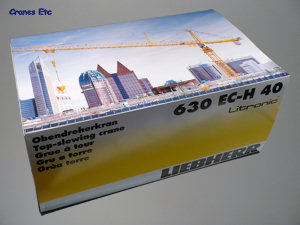 | | The large Liebherr picture sleeve. |  | 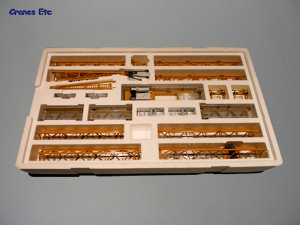 | | Middle section has the jib and counter jib sections. | 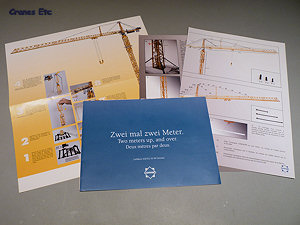 | | Various leaflets are supplied. | 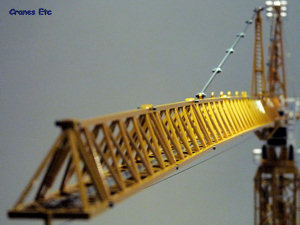 | | This photo shows the jib as assembled out of the box. By inserting some spacers as in the photo below, the straighter profile in the photo on the right can be achieved. | 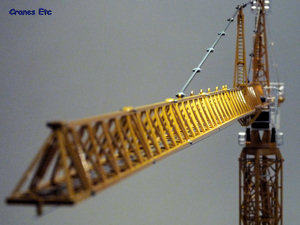 | | The straighter profile after inserting spacers. | 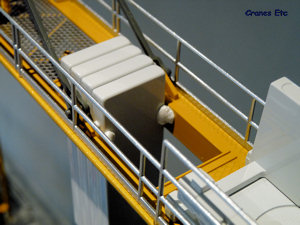 | | If using less than the full amount of counterweight, use plastic putty to prevent the blocks slipping out. | 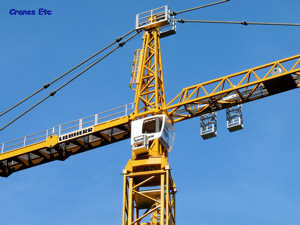 | | Access platforms at the top of the A frame, and on the jib for enabling access to the trolleys and hooks. | 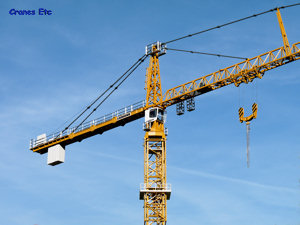 | | It looks very convincing on the skyline. | 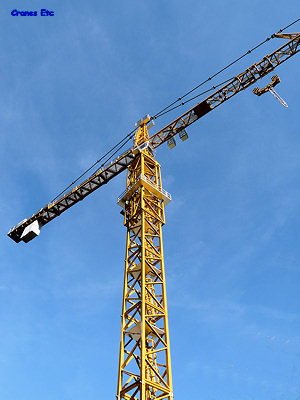 | | The mast is rock solid and dead straight. | 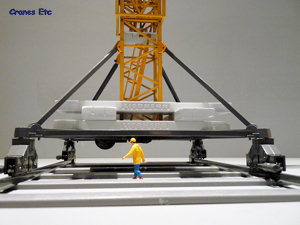 | | The massive proportions of the cruciform base are obvious as the Cranes Etc team member is about to bump his head. | 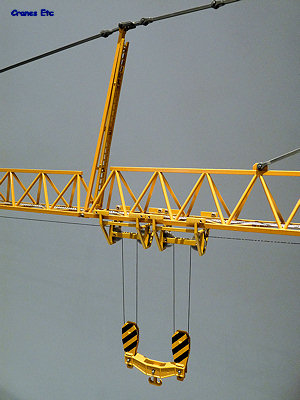 | | Double trolley and double hook in 4-fall mode. | 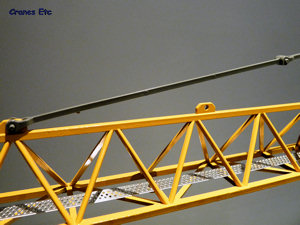 | | Pendants are plastic, but good quality and less flexible than on previous models. | 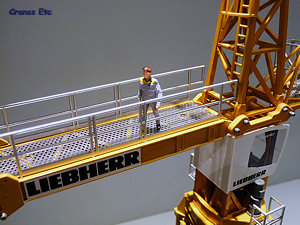 | | The heavy counter jib complete with 'Liebherr man'. | 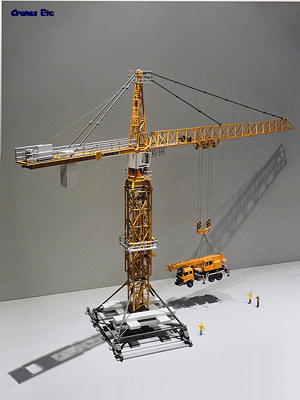 | | The model rigged in its smallest configuration. It can lift some pretty decent loads. Here it lifts the Liebherr LTF1030. | 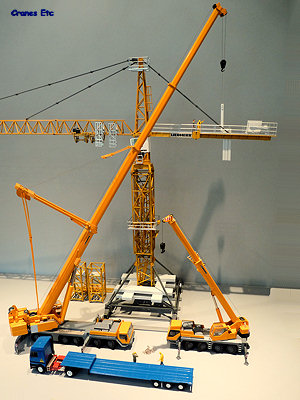 | | Removing the counterweight slabs. | 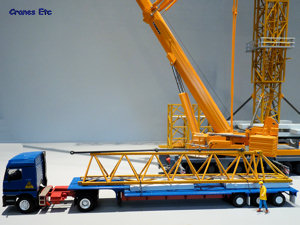 | | Jib and slabs make a good truck load. | 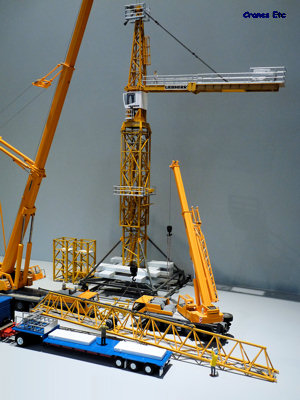 | | Landing the jib so it can be split down by the assist crane. | 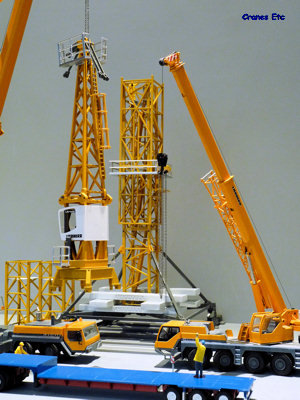 | | Removing the cab. | 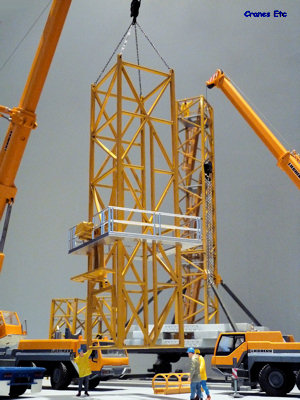 | | Lowering the climbing frame. |
| Liebherr have commissioned many tower crane models and with the exception of mobile tower cranes these have previously been 1:87 scale. At the BAUMA exhibition in 2007 a prototype of this 1:50 scale model of one of the largest tower cranes built by Liebherr was presented, and it entered production a year later.
The real 630 EC-H 40 has a maximum capacity of 40 tonnes at 15m radius, and can be configured with jib lengths of up to 80m. It can also free stand to a height of 80m.
The model is made by Conrad in Germany and includes all the parts needed to display the largest freestanding configuration of the real crane, and also some alternative configurations.
Packaging
The model box is in the typical Liebherr style with a picture sleeve enclosing three expanded polystyrene trays and lid, which are loaded with parts. The packaging is effective and the review model had no damage or missing parts.
Four leaflets are supplied with the model. The first is a Conrad booklet which celebrates the achievement of the model - it is obviously something Conrad is proud of. It claims to be the first 1:50 scale mass produced tower crane, although in fact it was beaten to the marketplace by the Potain MDT178. The second leaflet is a typical Liebherr model style instruction leaflet with numbered pictures and printed in five languages although in reality it is far too brief to explain how to build the model properly. Fortunately the remaining two leaflets make up for the shortfall. They are identical, but cover four languages with Italians unfortunately missing out compared to the other leaflet. These instructions are much better and include some proper diagrams to explain the bolting arrangements and the pendant layouts, although there is no inventory of parts.
This is a very big model so plenty of space is needed. It should be possible to build it in a couple of hours. On the whole the parts fitted very well with a little work needed to push home some of the plastic bolts.
Before commencing assembly check all mast sections to ensure that the opening in the ladder platforms are all aligned the same way relative to the side of the mast that has additional bracing. According to the instructions this should be on the opposite side to the additional bracing but on the review model this was largely reversed and as shown in a photo on this page. Some mast sections had the platform fixed differently but these were easy to push out and make consistent with the rest.
When building the mast all the additional bracing must be on the same side as the climbing frame uses the horizontal bracing to push off when raising the crane.
The jib at full length is reasonably straight but the last two sections sag just a little and this is visible from some angles. It is possible to straighten the jib more however by fitting appropriate spacers at the lower jib connection points. The effect of this is shown in the photos on this page. For the review model it was found that small pieces of an old credit card were just the right thickness to achieve the difference.
Although not mentioned in the instructions it is possible to assemble the model in different jib configurations by using different combinations of pendants. There are not enough parts to replicate the various arrangements of the real crane precisely, but most collectors will be more than satisfied with the options available. A graphic showing the possible configurations is included on the right.
For short jib configurations the model could be displayed with less than the full complement of counterweight. If so, care has to be taken that the blocks do not slip out through the opening. It is recommended to secure the blocks by using plastic putty or a similar method as shown in the photo.
Detail
The model stands on some rail track and this is made up of large plastic sleepers (ties) with metal rails which slot in. Each rail has stops at the end to stop the crane coming off the end, but this does mean there is no prospect of making a longer track. The arrangement is quite robust although to move the layout means rebuilding it as the parts only loosely push-fit together.
The cruciform base is suitably large and has excellent metal bogies with metal wheels showing that no corners have been cut to produce a model that can cope with the stresses put onto it. The orientation of the base is not quite right though, as the cable drum should spool out along the track not to the side of it, and all the bogie drive motors should be on the inside. It is possible to correct these issues by adjusting the bogie feet.
The cruciform can be split down smaller by undoing a screw but this does not create realistic transport loads for the pieces that remain. Ballast slabs are used to add weight to the bottom of the crane and on the model these are solid plastic so they are not as heavy as metal, although they look pretty good.
The first two mast sections are 630 EC-H 'specials' with the lowest piece having four plastic connections for struts. These connections are prone to splitting when inserting the plastic bolts (which are a tight fit) so care is needed. The second mast section is a double height piece. All of the mast sections, and with ten 500 HC sections, there are twelve in all, are very strong components and fix together using the small plastic bolts favoured by Conrad. With that said, the mast is rock solid when assembled and dead straight too which is a considerable feat of model engineering.
Each mast section has a platform for the operator to change ladders whilst ascending and these have an excellent textured surface. The ladders are loose pieces, and each one has a plastic safety cage. Overall the effect is visually good, although ladders at the very top and bottom of the mast are missing because of the design used. To make the model look right care has to be taken to align the mast sections correctly. A plastic capacity notice board is provided and this clips onto the bottom of the mast and is a welcome touch.
Included with the model is a climbing cage, and this is a slightly strange piece as it does not include the working platform at the top of the frame, and disappointingly it does not include a tray to land a mast section during the climbing operation. In other respects it is detailed, with a hydraulic pump and piston, and the walkway has a good textured deck and nice looking handrails. At this scale the handrails on the whole model are perhaps a shade too large, but they are certainly robust.
The cab section has a very heavy structure around the slew ring area and there are two plastic slewing motors together with access platforms. The cab exterior is plastic, but you would hardly know it and inside there is an operator's seat and controls, and the internal structure of the crane is accurately replicated.
Above the cab the tall 'A' mast head is attached and this is a very well cast piece which includes an access ladder and safety cage, although the cage is a little too short and should really extend to the access platform above. It is possible to achieve this by adding one of the safety cages from an unused mast section to make a pair. At the top a couple of metal access platforms clip on. The plastic attachment points for the jib pendants is permanently attached.
The counter jib is made up of four sections and these are surprisingly heavy all-metal constructions. The structure is authentically reproduced with triangular bracing, and the deck has a good mesh walkway and hand railing. At the back, the last counter jib section is the largest piece and features the main winch and electric equipment cabinet. The motor and cabinet are not highly detailed, and actually would have looked better if they had been painted dark grey instead of the faux concrete colour used on the ballast blocks.
Turning to the ballast blocks, these are heavy pieces with small protrusions which retain the blocks on the counter jib. This works fine when all the blocks are loaded as they cannot fall out, however if a lesser configuration is used then there is a real risk of a piece rotating slightly and falling. It would have been better if the counter jib had matching depressions in the casting so that each block would have been secure and this would have been closer to the arrangement in the real crane. The blocks also lack lifting eyes so posing blocks being lifted whilst the crane is being erected or dismantled is harder to achieve.
The main jib consists of eight separate sections and in terms of casting they are excellent. Each one is fully triangulated and cast in one piece so they are very strong and very accurately made meaning they join together perfectly. A mesh walkway runs the full length of the jib. A trolley motor is included on the first jib section which looks fine although it does not have the split drum that it needs. Also a couple of access frames clip onto the jib near the cab to enable technicians to get to the trolleys and hooks.
An omission on the jib is the pulleys necessary to enable the trolley movement ropes to be hung and this is a disappointment given that even some 1:87 scale tower crane models have this.
The pendants that hold the jib and counter jib are plastic and are of a stiffer variety than on previous Conrad models, and they have bolted connections. They are a distinct improvement. Two trolleys are supplied with the model and these are metal with false rollers which give a smooth ride along the jib nonetheless. The trolleys do not have a travelling basket attached as is found on the real crane. The large pulleys in the trolleys are plastic and roll well.
The hook blocks are metal with a large plastic pulley and the linking beam that joins the two blocks in 4-fall mode is a nicely made part. A separate hook is provide for use in 2-fall operation.
Some other accessories are included with the model. There is a spare base ballast block with lifting strops which can be used to form a load for the crane. There is also a very large plastic Liebherr sign which can be attached on the underside of the counter jib but it is doubtful whether most collectors will want to attach this as it does not look particularly realistic.
A 1:50 scale man (made by Preiser), dressed in Liebherr overalls, is supplied with the model and this makes a nice addition.
Features
The crane rolls very smoothly on the wheels in the bogies of the cruciform base, although the length of travel is limited by the short rails.
Despite the weight and stresses involved, the crane rotates well, and the winch can be used to lift some heavy loads without slipping. It is a pity that it does not have a working trolley mechanism and on the face of it is hard to see why this was not detailed in the model. The keen collector would be able to use the thread included on the trolley motor to attach to the trolleys to increase the realism.
A large number of display options are possible with the model. It can be built up to any height using the large number of mast sections provided, and this can be with or without the climbing frame included. Different configurations of jib and counter jib are possible. In fact the size of the model is one of its great features.
Fully built up it is over 6ft (2m) tall and about 7ft (2m+) tip to tip and is therefore impressive to anyone. Not only that, it is not in the least bit flimsy or about to tip over, and feels really solid.
The model can also be rigged with either a single or double trolley, and a single or double hook.
A particular strength of the model is that it is made up of sections which are representative of the real crane and this provides some interesting possibilities. It is possible to pose the crane being erected or dismantled using a suitable mobile crane model. Most of the parts also make excellent transport loads on haulage vehicles. The climbing frame is not suitable for this as the walkway is permanently fixed and the cruciform base also does not dismantle fully. However all other parts can be used as transport loads and even on the cab section the access platforms to the slewing motors can be removed to leave a great truck load.
Quality
There is no doubting the quality of the diecasting involved in making this model. All parts are made to very accurate tolerances and they fit together well. There is relatively little plastic used and where it is used it does not downgrade the look of the model. The paintwork is very good.
In terms of detail the model is typical Conrad. On the whole it looks great but it lacks the finer detail found on modern high quality models made in China.
Price
This is not a cheap model but it offers a hugely impressive display, and it has all the parts necessary to complete a variety of configurations. There is a lot of metal used in its construction and overall is very good value.
Overall
Liebherr have been a strong promoter of tower crane models over the years and up to now these have been in 1:87 scale. With this model Conrad and Liebherr have taken the plunge into producing a large 1:50 scale model and there is no doubt that in terms of impressiveness alone it is a success. The design of the model allows plenty of flexibility in the ways it can be displayed and this is very commendable.
There are areas for improvement. It really should have a working trolley mechanism and the climbing frame should be able to support a mast section so that the model can be posed set up for climbing. Additional detail would always be welcomed.
What has to be fully appreciated is the general excellence in the quality of the diecasting that this model represents. The stresses on the model are large and yet it gives confidence that it is rock solid. Overall it is a top class model.
Footnotes
The model first appeared as a prototype at the BAUMA Exhibition in April 2007. The model appeared at dealers from April 2008 onwards. A version in Vinci colours (red and blue) was shown at the 2009 Nuremberg Toy Fair.
|
| |
| 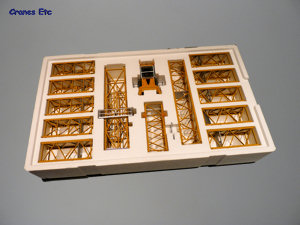 | | The top tray holds the mast sections, climbing frame and cab. | 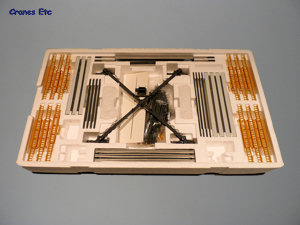 | | Bottom tray has the cruciform base, small parts and the mast ladders. | 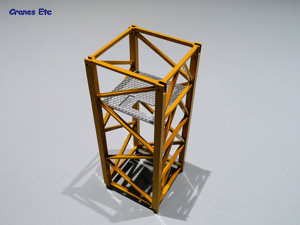 | | A mast section showing how the ladder platform is oriented on the review model, which is opposite to that in the instructions. | 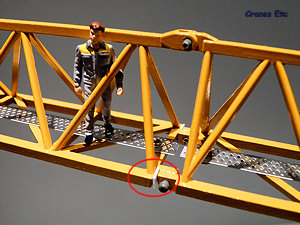 | | To achieve jib straightening insert some spacers as circled. | 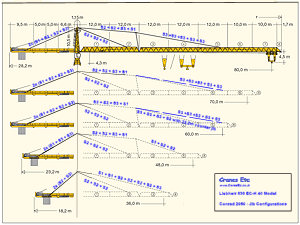 | | The various combinations of jib configurations of the real crane, and the suggested arrangement of pendant bars using the S1, S2, and S3 terminology of the supplied instructions. These apply to the first run of the model. | 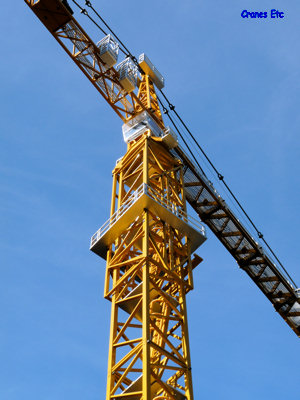 | | Looking up to the climbing frame. It misses out on the top platform and does not have a tray to hold a mast section ready for insertion. | 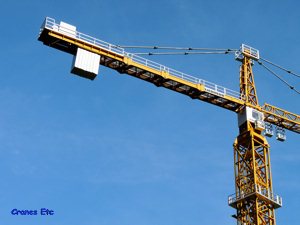 | | The counter jib has excellent structure, mesh walkways and handrails. | 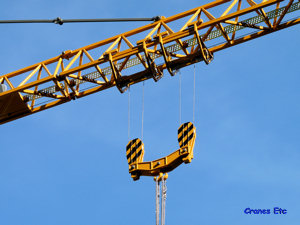 | | Mesh walkways extend the length of the jib. | 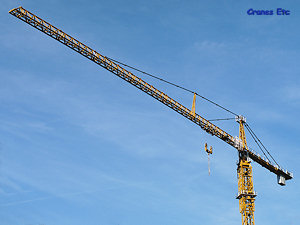 | | The main jib is straight, curving very slightly at the end but this can be rectified as mentioned earlier. | 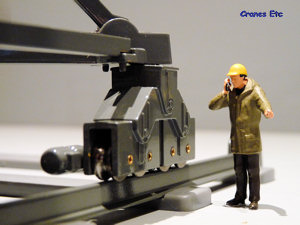 | | 'There's a massive bogie'. | 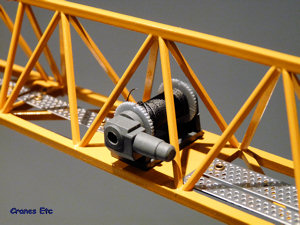 | | The trolley motor is modelled and has thread - but no where to run it to. | 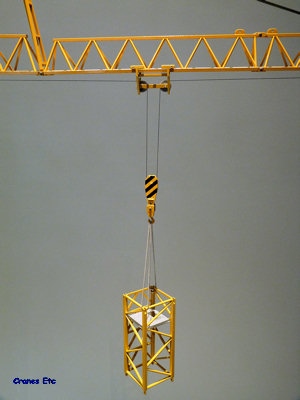 | | Single trolley and single hook mode. | 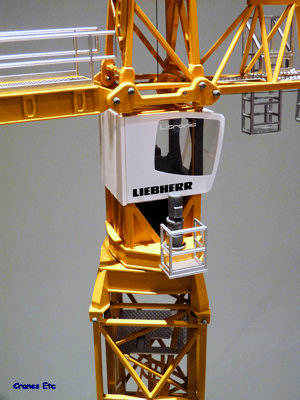 | | Characteristic Liebherr cab with internal structure. | 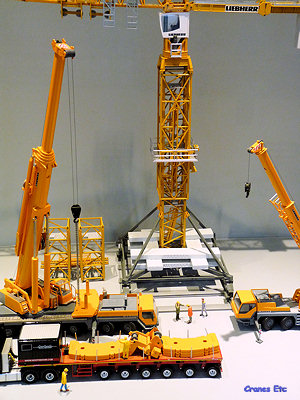 | | It is time to dismantle the crane. A Liebherr LTM1300, LTM1060 and Nooteboom OVB-102-06 ballast carrier arrive. | 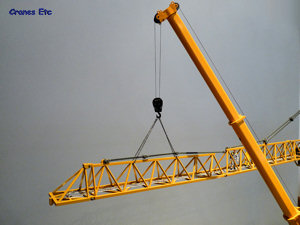 | | Disconnecting the first section of jib. | 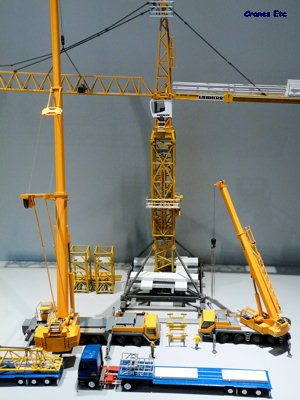 | | Preparing to take off the rest of the jib. | 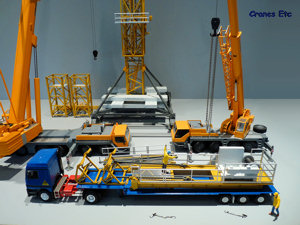 | | Part of the counter jib and trolleys on a truck. | 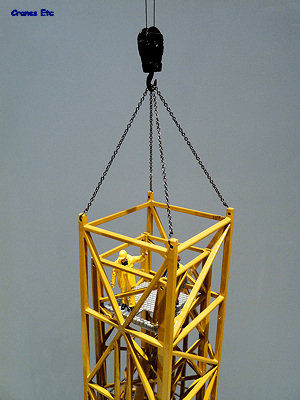 | | The climbing frame lifts off. Sword Chains and Hooks are being used. | 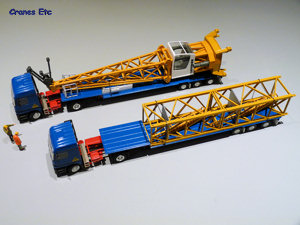 | | More great-looking truck loads. |
|

